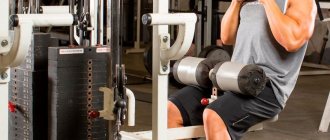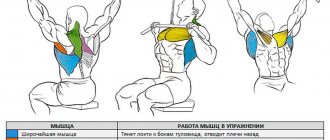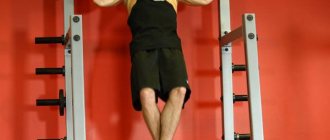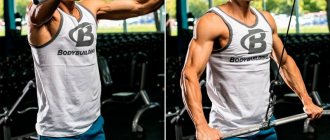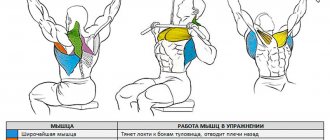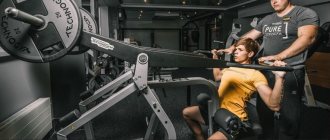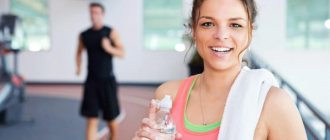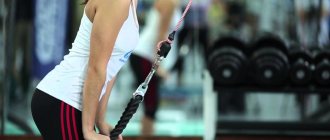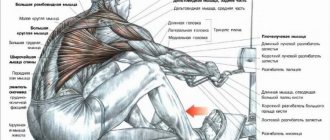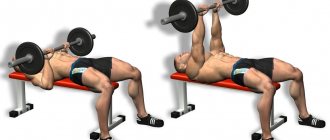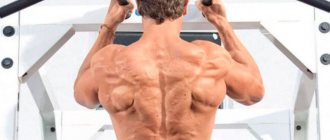In this article we will look at all types of grip, options for performing deadlifts, analyze mistakes and tell you how to increase the effectiveness of each exercise.
- — What muscles work
- — Vertical block traction options
- — Overhead row technique
- ——- Behind the head with a wide grip
- ——- To the chest with a wide grip
- ——- To the chest with a narrow grip
- ——- Parallel grip
- ——- Reverse grip
- — General recommendations
What muscles work in the exercise
The vertical block pull-down is a basic exercise for pumping up the back.
It’s easy to guess which muscles work in this movement:
- The latissimus, teres and rhomboids muscles of the back are the main moving muscles
- The lower part of the trapezius and the posterior bundle of the deltoid muscle are the second most involved in the movement
- The biceps and forearms perform an auxiliary function. With the difference that the biceps is loaded in a dynamic mode, and the forearm - in a static mode
How to learn to do pull-ups?
First, let's figure out why women find pull-ups so difficult?
The female body is biologically more resistant to external influences. However, some loads that are easily tolerated by men are too much for women. Simply put, a woman is better at long-term, low-intensity exposure, while a man is better at short-term, high-intensity tasks. How does this relate to training?
Unlike men, it is more difficult for women to do pull-ups; moreover, even with intense and properly organized training, not all women will be able to do pull-ups well. In push-ups, presses and rows for the superficial back muscles, the results will also be lower on average. In addition, a relatively weak upper body often limits performance in the deadlift and even the squat. BUT this is not a reason to conclude that women should train differently. The means (exercises) and methods (magnitude of load, number of approaches and repetitions) do not differ between women and men.
According to the results of a few studies, the strength of the upper body of women is 43–63% less, and the strength of the lower body is 25–30% less than that of men.
But still.. HOW TO LEARN TO PULL UP? FROM SCRATCH
Let's rid each other of the same type of advice like “strengthen your back/arms”, “play sports”, etc. I think this is already obvious. Here are the details you're likely missing.
- Correct grip:
Your fingers should be pointing towards you and your thumb should be gripping the bar from below. There are several types of grip that you can use when performing the movement, but this is a good place to start. Why? Yes, because the load with a reverse grip will be greater on the biceps, and it is larger in structure and can withstand a more serious load than the triceps.
Strong wrists
Strengthen your wrists by hanging for a minute
To do a pull-up, it's important to have a fairly strong wrist, which most of us don't have. Grab the bar with an overhand grip and straighten your arms
Hang as long as you can first. Ideally, bring this exercise to 60 seconds. To make the task more difficult, hang small weights of 1-2 kg on your legs or shoulders.
Another good way to develop weak wrists
Negative repetitions. (see picture)
Beginners should use negative repetitions. To do this, you need to lift it above the horizontal bar using, say, a chair. If the crossbar is located on a wall bars, then this is simply an ideal option. Place your feet on it and grab the bar from above. When you have taken the starting position, begin to slowly lower down. After this, rise again to the starting position and perform the next repetition. Perform 3 to 5 repetitions in this mode, 5–7 repetitions each.
By the way, a repetition is considered valid when the chin rises above the level of the crossbar.
Insurance
Ask for someone to back you up while doing pull-ups. As soon as you already feel the strength to completely do this exercise, you will need an assistant in the person of a trainer, the most handsome man in the gym or a girlfriend.
Grab the bar from above, hang and try to pull yourself up to chin level on your own. If at any level you don't have the strength, have a helper push you up a little. In the process of training, you will be able to do without it.
What is better - traction for the head and chest
The vertical or overhead row is an exercise that is widely used in bodybuilding.
In this case, there are two types of execution techniques - behind the head and to the chest.
There is still a myth about the different effects on the lats of these two traction options, but sports scientists have long proven that they have no fundamental difference.
When pulling a block behind the head, in addition to the lats, the deltoids and trapezius work quite actively. For a basic exercise this is a plus. But at the same time, the shoulder joints receive increased load - which is a big disadvantage.
Shoulders are fragile joints that can fail if moved carelessly, even with not very heavy weight. If you lack mobility or already have problems in the area, it is better to avoid this method of execution.
With the chest pull option, there is less activation of the deltoid and trapezius muscles, but the traumatic load on the shoulders is also reduced.
However, the head pull remains a popular movement, especially among beginners. And it's easy to explain.
When performing the option behind the head, it is easier to control the work of the back and the retraction of the shoulder blades. That is, the load on the latissimus dorsi muscles is felt more.
Basic rules for completing a workout
To prevent soreness caused by the accumulation of lactic acid in the muscles after exercise, you must adhere to the following recommendations:
- Every time before training, do a warm-up, and then stretch: standing straight, bend your chest forward, move your pelvis back. Bend your back at the thoracic region, then bend it back as far as possible. Bring your shoulders forward, stretch your arms forward and down. Move your chin following your hands. Stretch your arms as far as possible and return to the starting position. The tension should be felt in the area of the shoulder blades.
- End each workout with aerobic exercise (10 minutes on an exercise bike or treadmill).
- After each approach, take a break for 30 seconds.
Typical mistakes and recommendations for improving technology
The vertical head pull is a fairly simple technical exercise. This is one of the main reasons for its prevalence among beginners.
But still, certain technical errors are allowed in it.
Execution using arm strength
In bodybuilding slang this is called a “biceps pull.” Accordingly, most of the load falls on the biceps brachii muscle, and the back is not felt at all during movement.
Correct technique is based on the ability to direct the load into the back muscles.
To do this, in the starting position, when the arms are still straight, open the chest, slightly bend the lower back and slightly bend the torso forward. At the same time, the shoulder blades are slightly pulled together.
This starting position ensures contraction of the latissimus muscles already at the start.
Start the movement by bringing your shoulder blades together, not by bending your elbows.
Concentrate on working the target muscles. The hands act as levers that simply transmit impulse from the lats to the handle of the block.
Moving pace is too fast
Another common mistake is a sharp, jerky lowering of the projectile down and an inertial upward movement. This “dirty” technique has nothing to do with pumping the latissimus muscles.
The most appropriate tempo of movement when performing vertical overhead rows is 2-1-2.
This means smoothly lowering the pulley handle down within two seconds. Next - one second of fixation in the lower position, with additional tension of the back muscles, and a two-second smooth return of the weight to the starting position.
Straightening your arms
Try not to straighten your arms at the elbow joints in the top position until the end.
With straight arms, the first part of the movement occurs not due to muscle strength, but due to ligaments. This puts additional stress on them (mainly the elbow and shoulder ligaments are affected), and also overloads the shoulder joint. This can subsequently lead to injuries and discomfort after exercise.
Always keep your arms slightly bent. This ensures constant muscle tension in the back muscles and removes unnecessary stress from the ligaments.
Movement amplitude
Some practitioners lower the bar to the level of their shoulder blades. Women who naturally have good flexibility in their shoulder joints are especially “talented” in this regard.
By lowering the handle below neck level, you strain only the muscles of your arms, and your back is no longer involved in the movement. In addition, a large load falls on the shoulder joints.
Proper technique involves lowering the bar to the top of your traps.
Many bodybuilders, due to large muscle mass or stiffness in the shoulders, generally lower the handle to earlobe level. But even such a reduced amplitude does not prevent them from effectively pumping the latissimus dorsi muscles.
The main thing here is maximum control over the work of the target muscles and those points that we talked about above.
Execution technique
Take the correct starting position. Sit on the machine and place your feet under the special support rollers. Grasp the handle with a wide grip and straighten your back. At the top point, the arms are extended, the elbows are extended, but the muscles are not relaxed, but are in good shape.
The pull is performed as follows:
- As you exhale, pull the cable handle down. Move your head slightly forward and lower the handle to a level just below the back of your head. During movement, the gaze is directed forward, the straight position of the back is maintained, and the elbows move in an arc in a plane perpendicular to the floor.
- At the bottom point, hold for several counts and, while inhaling, slowly return to the starting position.
- Repeat the described movement 10–15 times.
Additional attention should be paid to the grip. As was said, the grip is wide. But how much? With the correct grip, when you bend your elbows at right angles, your forearms are perpendicular to the floor. This is about one and a half times wider than the shoulders.
You should also take into account the fact that deadlifts additionally engage the biceps. Performing the movement by bending your arms is one of the most common mistakes in this exercise. To avoid it, concentrate on your elbows. It is the elbows that move downwards with force, and the forearms and hands are simply hooks with which you catch the weight.
If during a lat workout you feel that your biceps are tired much faster than the set is completed, then you are doing the exercise incorrectly. Try to perform the movement using your back - it is the back that should get tired.
Inclusion in the training program
Thanks to its technical ease, the vertical overhead pull-down is suitable for everyone - from beginners to professional bodybuilders.
For most beginners, this is one of the main (if not the main) exercises for pumping up the back muscles.
As a rule, beginners put it first or second in their training program. In this case, light and medium weights are used, in the repetition range - 10-15 times per approach.
The main goal during this period is not lifting kilograms, but learning the correct movement technique. And also the development of the connection between the brain and muscles, which helps to feel and constantly control the lats.
For intermediate and advanced levels, the exercise is used more variably.
When training for mass, it can be the first in the program, used as a warm-up (light weight and 10-15 repetitions per approach). Or maybe the first, heavy movement on the back (medium weight and 8-12 repetitions).
The deadlift is also placed in the middle or at the end of the complex, using it as a finishing movement . In this case, a pump load mode is used - light weight and 12-15 repetitions per set, with minimal rest - up to a minute.
The upper block behind the head is often used when training for relief and detailing of the back muscles. Here they use light weight and the same 12-15 repetitions per approach, but the tempo of movement changes to 2-2-2. That is, the phase of maximum contraction of the back muscles increases to two seconds.
Preparation
Before you start training, you need to choose a suitable weight and decide on the number of repetitions. The weight used depends on the fitness level and goals of the athlete. For beginners, it is better to start training with minimal weights to develop the technique.
As a rule, the exercise is done 10–15 times, 2–3 times each.
Regardless of the duration of the workout and the weights used, be sure to warm up before class. Finally, you need to relax your muscles by stretching. Following these simple rules will make your workout safer and more effective.
Block row or pull-up
In terms of stimulating muscle growth, pull-ups on the bar are far ahead of pull-downs. Therefore, if you can do pull-ups, and even with different types of grips, the choice of exercise is obvious.
The vertical block row can be used as a finishing exercise at the end of the back complex.
If you are a beginner and the crossbar is too tough for you yet, practice on a block. The transition to the horizontal bar as a basic movement will occur as your training level increases.
AND A FEW MORE EXERCISES TO PUMP YOUR BACK MUSCLES
Stretching the latissimus dorsi muscles - standing swinging your arms. Stretching the latissimus dorsi muscles - standing swinging your arms. Photo - Women: Rows from the lower block to the chest. Rows from the lower block to the chest. Photo - Women Crossover rows from upper blocks Crossover rows from upper blocks. Photo - Women Gironde pull-up with a reverse grip (to the chest) Gironde pull-up with an overhand grip (to the chest). Photo - Women Stretching with kneading the latissimus dorsi muscles while lying on the floor Stretching with kneading the latissimus dorsi muscles while lying on the floor. Photo - WomenStretching the latissimus dorsi muscles while standing with support on a wall.Stretching the latissimus dorsi muscles while standing with support on the wall. Photo - Women Stretch of the lats hanging on one arm. Stretch of the lats hanging on one arm. Photo - Women Stretching the back muscles with a partner Stretching the back muscles with a partner. Photo - Women Pull-ups on the bar with a medium overhand grip - classic Pull-ups on the bar with a medium overhand grip - classic. Photo - WomenRocky pull-ups - to the chin - behind the neckRocky pull-ups - to the chin - behind the neck. Photo - Women Pull-ups on the bar with lateral movements Pull-ups on the bar with lateral movements. Photo - Women Stretching the back muscles while lying on the floor on your side Stretching the back muscles while lying on the floor on your side. Photo - Women Straight arm rows from shoulder level from the top block Straight arm rows from shoulder level from the top block. Photo - WomenReverse grip rows from the upper block while seatedReverse grip rows from the upper block while seated. Photo - Women: V-shaped chest rows from the upper block. V-shaped chest rows from the upper block. Photo - Women Pull-ups with a V-shaped grip Pull-ups with a V-shaped grip. Photo - Women Seated wide-grip chest rows from an upper block Seated wide-grip chest rows from an upper block. Photo - Women: Neck rows with a wide grip from the upper block while sitting. Neck rows with a wide grip from the upper block while sitting. Photo - Women Stretching the latissimus dorsi while hanging on a bar with a wide grip Pull-up on a bar with a wide grip. Photo - WomenAlternating bent-over kettlebell rowsAlternating bent-over kettlebell rows. Photo - Women Alternating rows of weights in a lying position Alternating rows of weights in a lying position. Photo - Women: Barbell rows to the stomach in a half-tilt. Barbell rows to the stomach in a half-tilt. Photo - WomenT-bar rows with one handT-bar rows with one hand. Photo - WomenT-bar row with two handsT-bar row with two hands. Photo - Women Bent-over dumbbell rows. Dumbbells along the shoulder line. Bent-over dumbbell rows. Dumbbells along the shoulder line. Photo - Women Bent-over dumbbell rows. Dumbbells along the body. Bent-over dumbbell rows. Dumbbells along the body. Photo - Women: Barbell rows to the chest on an inclined bench. Barbell rows to the chest on an inclined bench. Photo - Women Barbell rows with a curved bar lying on a bench, face down. Barbell rows with a curved bar lying on a bench, face down. Photo - Women T-bar rows in a chest-rest machine. T-bar rows in a chest-weight machine. Photo - Women Shrugs with dumbbells lying on an incline bench. Shrugs with dumbbells lying on an incline bench. Photo - Women Stretching the back muscles - Standing body turns. Stretching the back muscles - Standing body turns. Photo - Women Pull-ups on the bar with mixed grip Pull-ups on the bar with mixed grip. Photo - Women Pull-ups on the bar with one hand - reverse grip, the other with a grip on the towel. Pull-ups on the bar with one hand - reverse grip, the other - with a grip on the towel. Photo - Women Bent-over dumbbell rows to the chest with emphasis. Bent-over dumbbell rows to the chest with emphasis. Photo - Women Bent-over kettlebell row Bent-over kettlebell row. Photo - Women Bent-over barbell rows with a reverse grip Bent-over barbell rows with a reverse grip. Photo - WomenStretching the middle part of the back - rhomboid muscles - lying down with a rollerStretching the middle part of the back - rhomboid muscles - lying down with a roller. Photo - Women V-shaped grip rows to the stomach from the lower block V-shaped grip rows to the stomach from the lower block. Photo - Women: One-handed rows to the stomach from the lower block. One-handed rows to the stomach from the lower block. Photo - Women Bent-over barbell rows on a Smith machine Bent-over barbell rows on a Smith machine. Photo – Women Spinal stretching. Side crunches while sitting on a chair. Spinal stretch. Side crunches while sitting on a chair. Photo - Women: Bent-over rows of two weights to the stomach. Bent-over rows of two weights to the stomach. Photo - Women Stretching the back muscles while standing with clasped hands. Stretching the back muscles while standing with clasped hands. Photo – Women
Contraindications
The overhead pull-down is an exercise with a low risk of injury. This movement is suitable even for people with spinal problems. The same cannot be said about the pull of the upper block to the chest, where they often feel unpleasant discomfort in the back.
However, the head block still has one significant contraindication - diseases and injuries of the shoulder joint, since when performing the movement the shoulder is in an anatomically unfavorable position.
This also includes injuries to the muscles and ligaments that are involved in movement.
Possible mistakes
The exercise is considered basic and suitable for beginners, but many beginners make serious mistakes when performing it.
They make traction ineffective and do not give the desired result:
- lifting the buttocks off the bench while raising the arms;
- choosing too much weight, which does not allow you to perform the exercise with the correct technique and the required amplitude;
- hunched shoulders, incorrect position of the spine;
- redistribution of the main load from the back to the biceps.
After contraction, it is recommended to relax the muscles, but not completely - there should always be a slight tension. The results will make themselves felt in the future. At the extreme point, you need to straighten your arms, but at the same time keep your muscles in good shape.
Benefits of this exercise
- Targeted load on the rear deltoids. As a result, the shape of the shoulder improves. They become more spherical.
- The facelift helps strengthen the rotator cuff muscles, which are under stress not only during workouts, but also throughout the day when doing household chores. This reduces the risk of injury.
- Improved posture due to the development of the rhomboid muscles and trapezius. This not only affects the appearance, but also helps relieve the load on the spine.
- Increase results in basic exercises. Such as: Bent-over rows and SHRUGS.
- Elimination of imbalance in the development of deltoid muscles. This is especially important for bodybuilders. Since they strive for uniform muscle development.
